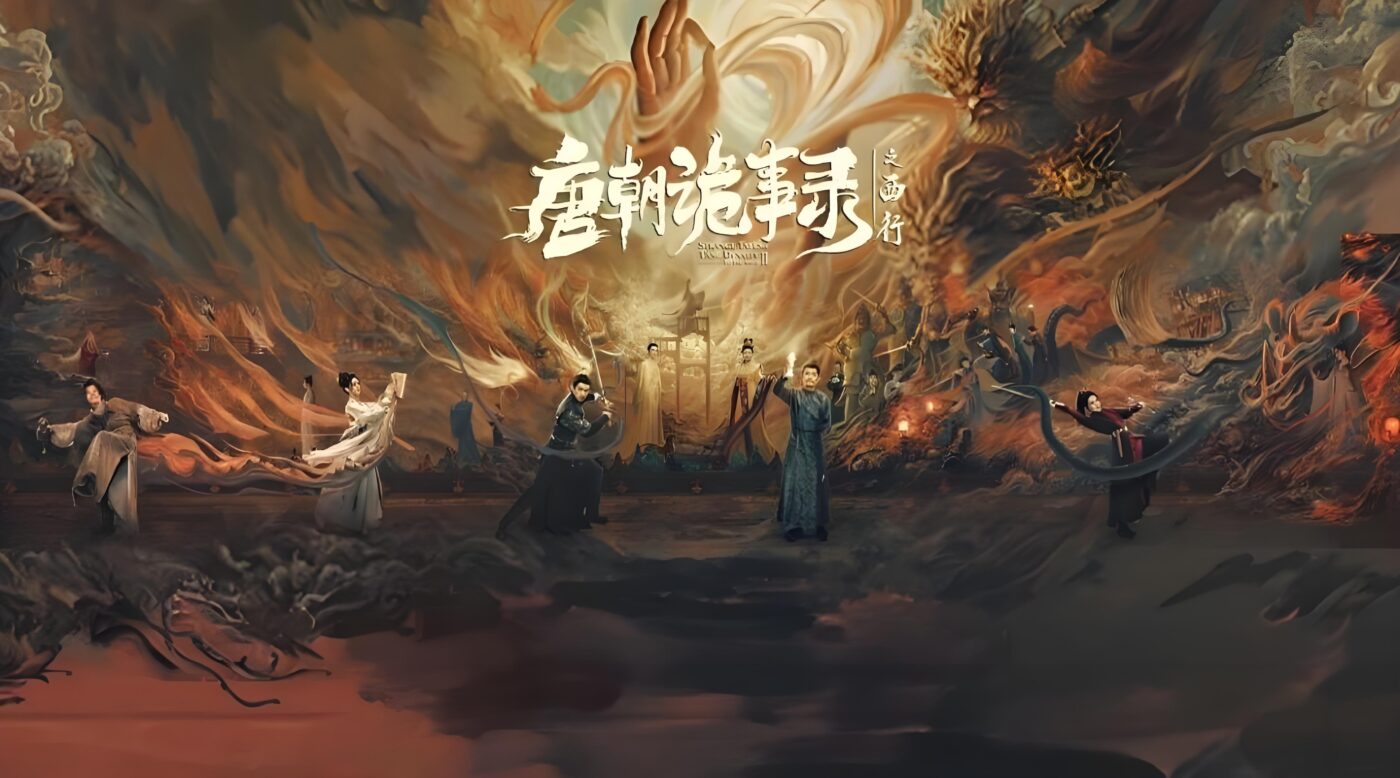唐朝诡事录 (The Chronicles of Strange Tales in Tang Dynasty) is a Chinese historical fantasy drama that has captivated audiences with its intricate blend of history, supernatural elements, and mystery. Set during the Tang Dynasty, one of the most prosperous and culturally vibrant periods in Chinese history, the series offers viewers a rich tapestry of stories that explore the mysterious and the unexplained within the context of a historical backdrop.
This drama is not only a visual spectacle, with its stunning cinematography and detailed period costumes, but also a narrative triumph that weaves together various legends, folklore, and historical events from the Tang era. By combining the real and the fantastical, 唐朝诡事录 provides a unique perspective on the lives and beliefs of people during this time, making it a compelling watch for those interested in Chinese history, culture, and supernatural tales.
Historical Context of the Tang Dynasty
The Tang Dynasty (618–907 AD) is often regarded as a golden age in Chinese history. It was a period marked by political stability, economic prosperity, and cultural flourishing. The Tang Dynasty is renowned for its advancements in literature, art, and technology, as well as its openness to foreign cultures and ideas, largely due to the Silk Road trade routes that connected China to the rest of the world.
The era also saw the rise of Chang’an (modern-day Xi’an) as one of the largest and most cosmopolitan cities in the world. The city’s bustling markets, grand palaces, and religious diversity reflected the Tang Dynasty’s wealth and power. It was during this time that poetry, particularly the works of poets like Li Bai and Du Fu, reached new heights, and Buddhism, which had been introduced to China centuries earlier, became deeply ingrained in Chinese society.
However, beneath the surface of this cultural and economic boom, there were also periods of political intrigue, rebellion, and social unrest. The Tang Dynasty, like any great empire, had its share of dark and mysterious events, some of which have been passed down through the ages as legends and folklore. These stories often involved supernatural occurrences, divine retribution, and the struggles between good and evil, reflecting the complex beliefs and superstitions of the time.
Plot Overview of 唐朝诡事录
唐朝诡事录 is a drama series that delves into these mysterious and supernatural stories, presenting them as a series of interconnected tales set against the backdrop of the Tang Dynasty. The drama blends historical facts with fantastical elements, creating a narrative that is both educational and entertaining.
The central plot of the series revolves around a group of characters, each with their own connections to the supernatural world. These characters, including scholars, officials, and ordinary citizens, find themselves embroiled in various strange and unexplainable events that challenge their understanding of the world. As they navigate these mysteries, they uncover hidden truths about themselves, their society, and the world beyond.
The drama is structured as an anthology, with each episode or set of episodes focusing on a particular story or mystery. These stories often involve elements of Chinese folklore, such as ghosts, spirits, demons, and other supernatural beings. However, rather than relying solely on horror or shock value, 唐朝诡事录 uses these elements to explore deeper themes related to human nature, morality, and the consequences of one’s actions.
One of the key strengths of 唐朝诡事录 is its ability to weave together multiple narrative threads, creating a rich and complex tapestry of stories that reflect the diversity and complexity of the Tang Dynasty itself. The drama also incorporates historical figures and events, adding an additional layer of authenticity and depth to the narrative.
Themes and Symbolism
At its core, 唐朝诡事录 is a meditation on the nature of truth, belief, and the unknown. The series frequently explores the tension between the rational and the supernatural, questioning what can be known or understood in a world where the boundaries between reality and fantasy are often blurred. This theme is particularly relevant in the context of the Tang Dynasty, a period where Buddhism, Daoism, and Confucianism coexisted and influenced the ways in which people perceived the world around them.
The supernatural elements in 唐朝诡事录 are often symbolic, representing the fears, desires, and moral dilemmas faced by the characters. For example, encounters with ghosts or spirits might reflect unresolved guilt or the consequences of past actions. Similarly, interactions with divine or demonic beings can symbolize the internal struggles between good and evil, or the search for spiritual enlightenment.
The series also touches on themes of justice and retribution, with many of the stories involving moral lessons or cautionary tales. Characters who engage in immoral or unethical behavior often face supernatural consequences, reflecting the traditional Chinese belief in karma and the idea that one’s actions will ultimately determine their fate.
In addition to these philosophical and moral themes, 唐朝诡事录 also serves as a reflection on the cultural and social dynamics of the Tang Dynasty. The drama portrays the Tang era as a time of great cultural exchange and diversity, but also one of social hierarchy and political intrigue. The characters often navigate complex social and political landscapes, where power and influence can be as dangerous as any supernatural force.
Character Development and Performances
The characters in 唐朝诡事录 are richly drawn and multidimensional, with each playing a crucial role in the unfolding mysteries. The drama features a diverse cast of characters, including scholars, officials, soldiers, and ordinary citizens, each of whom brings their own perspective and background to the story.
One of the central characters in the series is a young scholar who becomes involved in investigating supernatural occurrences. Through his eyes, the audience is introduced to the mysteries of the Tang Dynasty, as well as the philosophical and moral questions that these mysteries raise. The scholar’s journey is one of both intellectual and spiritual growth, as he confronts challenges that force him to question his beliefs and understanding of the world.
Another key character is an official tasked with maintaining order in the empire. His pragmatic and sometimes skeptical approach to the supernatural provides a counterbalance to the more mystical elements of the story. However, as he becomes more deeply involved in the strange events unfolding around him, he too is forced to confront the limits of his knowledge and the possibility that there are forces at work beyond human comprehension.
The performances in 唐朝诡事录 are one of the drama’s highlights, with the cast delivering nuanced and compelling portrayals of their characters. The actors effectively convey the complexity of their roles, capturing the internal conflicts and emotional depth that drive the narrative. The chemistry between the characters, whether in moments of camaraderie or tension, adds to the drama’s overall impact, drawing viewers into the world of the Tang Dynasty and its mysteries.
Visuals and Cinematography
唐朝诡事录 is visually stunning, with high production values that bring the Tang Dynasty to life in vivid detail. The series makes excellent use of its historical setting, showcasing the grandeur and beauty of Tang-era architecture, fashion, and landscapes. From the bustling streets of Chang’an to the serene countryside, the drama’s cinematography captures the rich textures and colors of the period, immersing viewers in the world of the Tang Dynasty.
The costume design is particularly noteworthy, with elaborate and historically accurate attire that reflects the social status and cultural background of the characters. The attention to detail in the costumes, from the intricate embroidery to the use of luxurious fabrics, adds an extra layer of authenticity to the drama.
In addition to its historical accuracy, 唐朝诡事录 also excels in creating a sense of atmosphere and mood. The use of lighting, color, and camera angles enhances the suspense and mystery of the stories, drawing viewers into the supernatural elements of the narrative. The visual effects, while used sparingly, are effective in conveying the otherworldly nature of the supernatural encounters, adding to the drama’s sense of wonder and intrigue.
Reception and Cultural Impact
Since its release, 唐朝诡事录 has received widespread acclaim from both audiences and critics. The drama has been praised for its innovative approach to historical storytelling, combining the appeal of traditional Chinese folklore with modern cinematic techniques. Its ability to balance historical authenticity with imaginative storytelling has made it a standout in the genre of historical fantasy dramas.
The success of 唐朝诡事录 has also contributed to a renewed interest in the Tang Dynasty, as well as in Chinese folklore and supernatural stories. The drama has sparked discussions about the ways in which history and legend intersect, and how these stories can continue to resonate with contemporary audiences. Its exploration of philosophical and moral themes has also struck a chord with viewers, prompting reflection on the nature of belief, morality, and the unknown.
In addition to its cultural impact, 唐朝诡事录 has also been recognized for its contribution to the development of Chinese television dramas. The series has set a new standard for production quality, storytelling, and character development, influencing the direction of future historical and fantasy dramas in China.
As 唐朝诡事录 continues to captivate audiences with its rich narrative and stunning visuals, it stands as a testament to the enduring power of storytelling and the ways in which history, culture, and imagination can come together to create something truly extraordinary.

